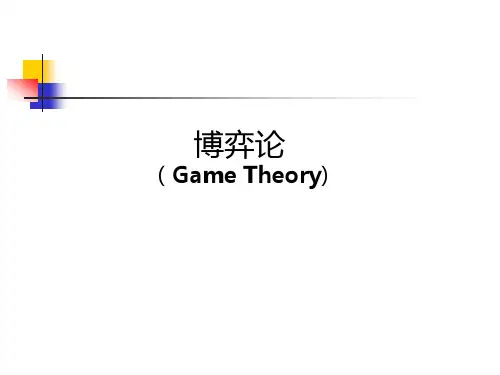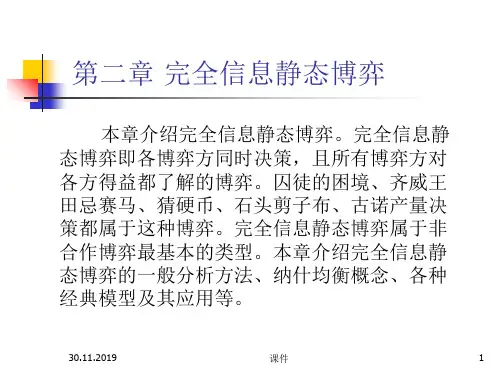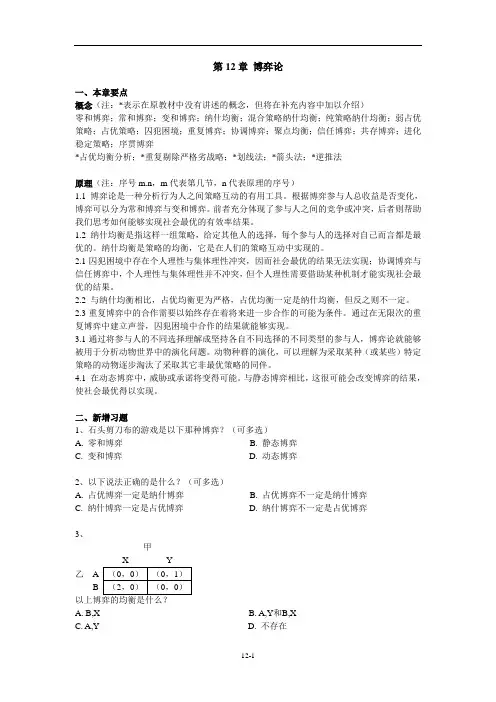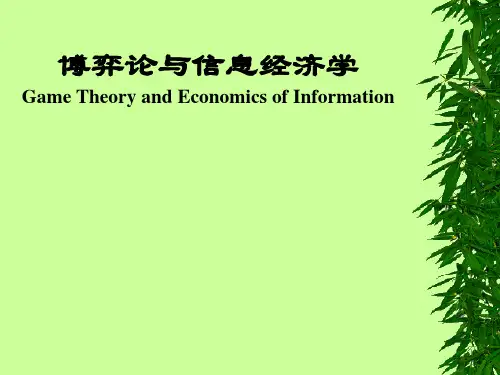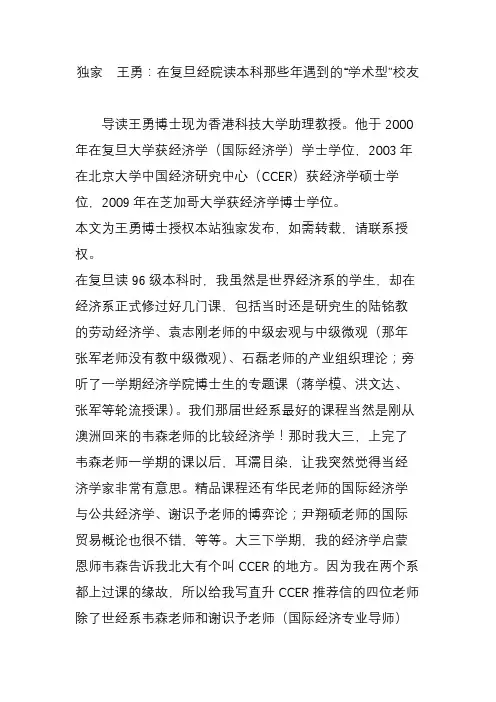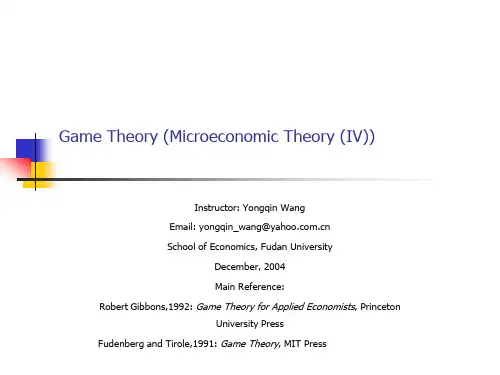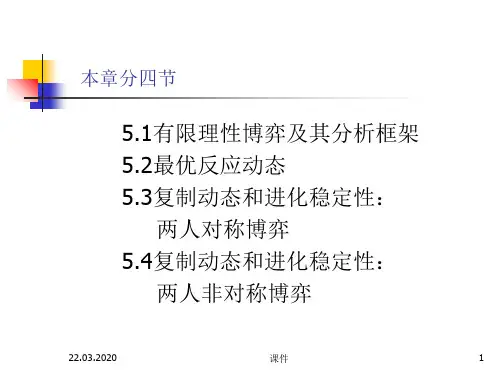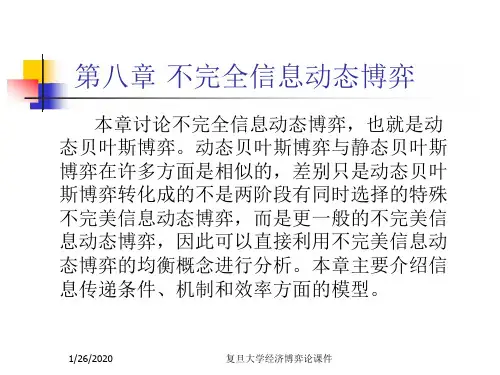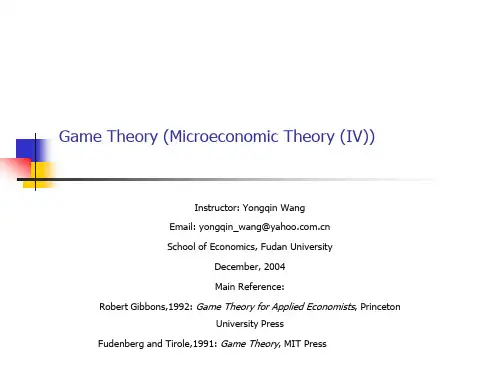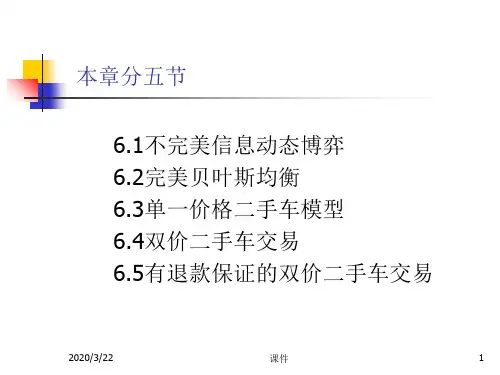- 1、下载文档前请自行甄别文档内容的完整性,平台不提供额外的编辑、内容补充、找答案等附加服务。
- 2、"仅部分预览"的文档,不可在线预览部分如存在完整性等问题,可反馈申请退款(可完整预览的文档不适用该条件!)。
- 3、如文档侵犯您的权益,请联系客服反馈,我们会尽快为您处理(人工客服工作时间:9:00-18:30)。
博弈论复旦大学中国经济研究中心
1.Static Game of Complete Information
1.3 Further Discussion on Nash Equilibrium (NE) 1.3.1 NE versus Iterated Elimination of Strict
Dominance Strategies
(2) Players 3 and 4 observe the outcome of the first stage
( a 1 , a 2 ) and then simultaneously choose actions and
from feasible sets A 3 and A 4 , respectively. (3) Payoffs are ui(a1,a2,a3,a4), i 1,2,3,4
Proposition A In the n -player normal form game
G { S 1,...,S n;u 1,...,u n}
if iterated elimination of strictly dominated strategies
eliminates all but the strategies (s1* , ..., sn* ) , then these
Cont’d
Proposition B In the n -player normal form game
G {S1,...,Sn;u1,...,un}
if the strategies (s1* , ..., sn* ) are a NE, then they survive
iterated elimination of strictly dominated strategies.
a a (1)Players 1 and 2 simultaneously choose actions 1 and 2 from feasible sets A 1 and A 2 respectively.
(2) Payoffs are u i(a 1 ,a 2,a 3 *(a 1 ,a 2),a 4 *(a 1 ,a 2))
;
1
2
i (3) The payoff to firm is given by the profit function
i(qi,qj)qi[P(Q )c]
P(Q)aQis the inverse demand function, Q q1 q2, and
c is the constant marginal cost of production (fixed cost being zero).
FOC:
v (G * * ) G * * v '(G * * ) c 0
(4)
Comparing (3) and (4), we can see that
G*G**
Implications for social and economic systems (Coase Theorem)
2. Dynamic Games of Complete Information
strategies are the unique NE of the game.
A Formal Definition of NE
In the n-player normal form G {S1,...,Sn;u 1,...,un}
the strategies (s1* , ..., sn* )
2.1 Dynamic Games of Complete and Perfect Information
2.1.A Theory: Backward Induction Example: The Trust Game
General features:
a (1) Player 1 chooses an action 1 from the feasible set A 1 . a (2) Player 2 observes 1 and then chooses an action a 2 from
d A dqA
a
2qA
qB
c
0
qA
a
qB 2
c
d 2 A dqA2
2
0
Cont’d
By symmetry, firm B’s problem. Figure Illustration: Response Function, Tatonnement Process Exercise: what will happens if there are n identical Cournot
2.1.B An example: Stackelberg Model of Duopoly
Two firms quantity compete sequentially.
q Timing: (1) Firm 1 chooses a quantity 1
0
;
q q 0 (2) Firm 2 observes and then chooses a quantity
Hardin(1968) : The Tragedy of Commons
Cont’d
There are n farmers in a village. They all graze their goat on the village green. Denote the number of goats the i t h farmer owns
goats to own (to choose g i ).
Cont’d
His payoff is
g iv ( g 1 ... g i 1 g i g i 1 ... g n ) c g i
(1)
In NE (g1*,..., gn*) , for each
i
,
g
* i
must maximize
least one NE, possibly involving mixed strategies.
See Fudenberg and Tirole (1991) for a rigorous proof.
1.4 Applications 1.4.1 Cournot Model
Two firms A and B quantity compete.
Cont’d
A maximum number of goats : Gmax:v(G)0 ,
for G Gmax but v(G) 0 for G Gmax
Also v'(G )0,v''(G )0
The villagers’ problem is simultaneously choosing how manyLeabharlann (1),given
that other farmers choose
(g1*,...,gi*1,gi*1,gn *)
Cont’d
First order condition (FOC):
v (g i g * i) g iv '(g i g * i) c 0 (2)
(where g * i g 1 * ... g i* 1 g i* 1 ... g n * )
are a NE, if for each player i,
s
* i
is (at least tied for) player i’s best response to the strategies
specified for the n-1 other players,
( s 1 * , . . . , s i * 1 , s i * , s i * 1 , . . . , s n * ) u i ( s 1 * , . . . , s i * 1 , s i , s i * 1 , . . . , s n * )
Here the information set is not a singleton.
Consider following games
(1)Players 1 and 2 simultaneously choose actions a 1 and a 2
from feasible sets A 1 and A 2 , respectively.
Cont’d
We solve this game with backward induction
q2argmax2(q1,q2)q2(aq1q2c)
q2 *R2(q1)aq21c
(provided that q1 a c ).
Cont’d
Now, firm 1’s problem
q1argm ax1(q1,R2(q1))q1[aq1R2(q1)c]
by g i , and the total number of goats in the village by Gg1...gn
c Buying and caring each goat cost and value to a farmer of
grazing each goat is v ( G ) .
Summing up all n farmers’ FOC and then dividing by n yields
v(G *)1G *v'(G *)c0 (3) n
Cont’d
In contrast, the social optimum G * * should resolve
m axG v(G )G c
Inverse demand function PaQ,a0
They have the same constant marginal cost, and there is no fixed cost.
